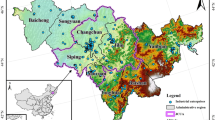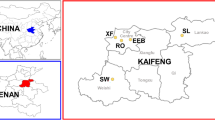Abstract
To better understand the characterization and secondary organic aerosol (SOA) formation of volatile organic compounds (VOCs) during non-haze and haze days, ambient VOCs were continuously measured by a vehicle-mounted online thermal desorption system coupled with a gas chromatography–mass spectrometry (TD–GC/MS) system in Shanghai, China. The average concentrations of VOCs in haze episodes (193.2 μg m−3) were almost 50% higher than in non-haze periods (130.8 μg m−3). VOC concentrations exhibited a bi-modal pattern in the morning and evening rush hour periods on both non-haze and haze days. The ratios of toluene to benzene (T/B) and m,p-xylene to ethylbenzene (X/E) indicated that VOCs were aged air mass transported from nearby areas. The estimated SOA yields were 12.6 ± 5.3 and 16.7 ± 6.7 μg m−3 for non-haze and haze days, respectively, accounting for 9.6 and 8.7% of the corresponding PM2.5 concentrations, which were slightly underestimated. VOCs–sensitivity (VOCs–S) based on a PM2.5-dependent model was used to investigate the variation between VOCs and PM2.5 concentrations in the morning rush hour. It was found that VOCs were more sensitive to PM2.5 on clean days than during periods of heavy particulate pollution. VOCs–sensitivity was significantly correlated with the ratio of specific PM2.5 to background PM2.5, with a simulated equation of y = 0.84x−0.62 (r 2 = 0.93, p < 0.001). Our findings suggest that strategies to mitigate VOC emissions and further alleviate haze episodes in Shanghai based on reducing gasoline vehicle-related sources would be very efficient.







Similar content being viewed by others
References
Ait-Helal W, Borbon A, Sauvage S, Gouw J, Colomb A, Gros V (2014) Volatile and intermediate volatility organic compounds in suburban Paris: variability, origin and importance for SOA formation. Atmos Chem Phys Dis 14(4):10439–10464. doi:10.5194/acp-14-10439-2014
Altieri KE, Stone A (2016) Prospective air pollutant emissions inventory for the development and production of unconventional natural gas in the Karoo basin, South Africa. Atmos Environ 129:34–42. doi:10.1016/j.atmosenv.2016.01.021
An J, Zhu B, Wang H, Li Y, Lin X, Yang H (2014) Characteristics and source apportionment of VOCs measured in an industrial area of Nanjing, Yangtze River Delta, China. Atmos Environ 97:206–214. doi:10.1016/j.atmosenv.2014.08.021
Atkinson R (1994) Gas-phase tropospheric chemistry of organic compounds. J Phys Chem 2:1–216
Atkinson R (2000) Atmospheric chemistry of VOCs and NO x . Atmos Environ 34:2063–2101. doi:10.1016/S1352-2310(99)00460-4
Atkinson R, Tuazon EC, Carter WPL (1985) Extent of H-atom abstraction from the reaction of the OH radical with 1-butene under atmospheric conditions. In J Chem Kinet 17:725–734. doi:10.1002/kin.550170703
Chen X, Hopke PK, Carter WPL (2011) Secondary organic aerosol from ozonolysis of biogenic volatile organic compounds: chamber studies of particle and reactive oxygen species formation. Environ Sci Technol 45:276–282. doi:10.1021/es102166c
Civan MY, Elbir T, Seyfioglu R, Kuntasal ÖO, Bayram A, Doğan G (2015) Spatial and temporal variations in atmospheric VOCs, NO2, SO2, and O3 concentrations at a heavily industrialized region in Western Turkey, and assessment of the carcinogenic risk levels of benzene. Atmos Environ 103:102–113. doi:10.1016/j.atmosenv.2014.12.031
de Gouw JA, Middlebrook AM, Warneke C, Ahmadov R, Atlas EL, Bahreini R (2011) Organic aerosol formation downwind from the Deepwater Horizon oil spill. Science 331:1295–1299. doi:10.1126/science.1200320
Dechapanya W, Eusebi A, Kimura Y, Allen DT (2003a) Secondary organic aerosol formation from aromatic precursors. 1. Mechanisms for individual hydrocarbons. Environ Sci Technol 37:3662–3670. doi:10.1021/es0209058
Dechapanya W, Eusebi A, Kimura Y, Allen DT (2003b) Secondary organic aerosol formation from aromatic precursors. 2. Mechanisms for lumped aromatic hydrocarbons. Environ Sci Technol 37:3671–3679. doi:10.1021/es0209060
Dinh TV, Kim SY, Son YS (2015) Emission characteristics of VOCs emitted from consumer and commercial products and their ozone formation potential. [J] Environ Sci Pollut Res 22(12):9345–9355. doi:10.1007/s11356-015-4092-8
Elbir T, Cetin B, Cetin E, Bayram A, Odabasi M (2007) Characterization of volatile organic compounds (VOCs) and their sources in the air of Izmir, Turkey. Environ Mon Assess 133(1–3):149–160. doi:10.1007/s10661-006-9568-z
Feng Y, Chen Y, Guo H, Zhi G, Xiong S, Li J (2009) Characteristics of organic and elemental carbon in PM2.5, samples in Shanghai, China. Atmos Res 92(4):434–442. doi:10.1016/j.atmosres.2009.01.003
Fu P, Kawamura K, Chen J, Miyazaki Y (2014) Secondary production of organic aerosols from biogenic VOCs over Mt. Fuji, Japan. Environ Sci Technol 48:8491–8497. doi:10.1021/es500794d
Galindo N, Varea M, Gil-Moltó J, Yubero E (2016) BTX in urban areas of eastern Spain: a focus on time variations and sources. Environ Sci Pollut Res Int 23(18):18267–18276. doi:10.1007/s11356-016-7019-0
Garzón JP, Huertas JI, Magaña M, Huertas ME, Cárdenas B, Watanabe T (2015) Volatile organic compounds in the atmosphere of Mexico City. Atmos Environ 119:415–429. doi:10.1016/j.atmosenv.2015.08.014
Geng F, Zhao C, Tang X, Lu G, Tie X (2007) Analysis of ozone and VOCs measured in Shanghai: a case study. Atmos Environ 41:989–1001. doi:10.1016/j.atmosenv.2006.09.023
Gentner DR, Jathar SH, Gordon TD (2016) A review of urban secondary organic aerosol formation from gasoline and diesel motor vehicle emissions. [J] Environ Sci Technol doi: 10.1021/acs.est.6b04509
Huang RJ, Zhang Y, Bozzetti C, Ho KF, Cao JJ, Han Y (2014) High secondary aerosol contribution to particulate pollution during haze events in China. Nature 514:218–222. doi:10.1038/nature13774
Kendrick CM, Koonce P, George LA (2015) Diurnal and seasonal variations of NO, NO2, and PM2.5, mass as a function of traffic volumes alongside an urban arterial. Atmos Environ 122:133–141
Lee SC, Chiu MY, Ho KF, Zou SC, Wang X (2002) Volatile organic compounds (VOCs) in urban atmosphere of Hong Kong. Chemosphere 48(3):375–382. doi:10.1016/S0045-6535(02)00040-1
Lim YB, Ziemann PJ (2009) Effects of molecular structure on aerosol yields from OH radical-initiated reactions of linear, branched, and cyclic alkanes in the presence of NO x . Environ Sci Technol 43:2328–2334. doi:10.1021/es803389s
Lin YC, Hsu SC, Chou CK (2016) Wintertime haze deterioration in Beijing by industrial pollution deduced from trace metal fingerprints and enhanced health risk by heavy metals. [J] Environ Pollut 208:284–293. doi:10.1016/j.envpol.2015.07.044
Liu H W, Wu B Z, Nian H C (2012) VOC amounts in ambient areas of a high-technology science park in Taiwan: their reciprocal correlations and impact on inhabitants. [J] Environ Sci Pollut Res 19(2):303–312. doi:10.1007/s11356-011-0558-5
Martins L, Vieira KM, Rios LM, Cardoso D (2008) Basic catalyzed knoevenagel condensation by FAU zeolites exchanged with alkylammonium cations. Catal Today 133–135(1–4):706–710. doi:10.1016/j.cattod.2007.12.043
Melymuk L, Robson M, Helm P A (2012) PCBs, PBDEs, and PAHs in Toronto air: spatial and seasonal trends and implications for contaminant transport. [J] Sci Total Environ 429(6):272–280. doi:10.1016/j.scitotenv.2012.04.022
Miller L, Xu X, Grgicak-Mannion A, Brook J, Wheeler A (2012) Multi-season, multi-year concentrations and correlations amongst the BTEX group of VOCs in an urbanized industrial city. Atmos Environ 61(12):305–315. doi:10.1016/j.atmosenv.2012.07.041
Mo Z, Shao M, Lu S, Qu H, Zhou M, Sun J (2015) Process-specific emission characteristics of volatile organic compounds (VOCs) from petrochemical facilities in the Yangtze River Delta, China. Sci Total Environ 533:422–431. doi:10.1016/j.scitotenv.2015.06.089
Nicolás JF, Galindo N, Yubero E, Crespo J, Soler R (2015) PM1, variability and transport conditions between an urban coastal area and a high mountain site during the cold season. Atmos Environ 118:127–134. doi:10.1016/j.atmosenv.2015.07.042
Pankow JF, Seinfeld JH, Asher WE, Erdakos GB (2001) Modeling the formation of secondary organic aerosol. 1. Application of theoretical principles to measurements obtained in the alpha-pinene/, beta-pinene/, sabinene/, delta3-carene/, and cyclohexane/ozone systems. Environ Sci Technol 35:1164–1172
Pereira KL, Hamilton JF, Rickard AR, Bloss WJ, Alam MS, Camredon M (2015) Insights into the formation and evolution of individual compounds in the particulate phase during aromatic photo-oxidation. Environ Sci Technol 49:13168–13178. doi:10.1021/acs.est.5b03377
Seinfeld JH, Erdakos GB, Asher WE, Pankow JF (2001) Modeling the formation of secondary organic aerosol (SOA). 2. The predicted effects of relative humidity on aerosol formation in the α-pinene-, β-pinene-, sabinene-, Δ3-carene-, and cyclohexene-ozone systems. Environ Sci Technol 35:1806–1817. doi:10.1021/es011025g
Shin HJ, Kim JC, Lee SJ (2013) Evaluation of the optimum volatile organic compounds control strategy considering the formation of ozone and secondary organic aerosol in Seoul, Korea. Environ Sci Pollut Res 20(3):1468. doi:10.1007/s11356-012-1108-5
Sun Y, Zhuang G, Tang A (2006) Chemical characteristics of PM2.5 and PM10 in haze–fog episodes in Beijing. Environ Sci Technol 40(10):3148–3155. doi:10.1021/es051533g
Sunder Raman R, Kumar S (2016) First measurements of ambient aerosol over an ecologically sensitive zone in Central India: relationships between PM2.5 mass, its optical properties, and meteorology. Sci Total Environ 550:706–716. doi:10.1016/j.scitotenv.2016.01.092
Tian S, Pan Y, Liu Z, Wen T, Wang Y (2014) Size-resolved aerosol chemical analysis of extreme haze pollution events during early 2013 in urban Beijing, China. J Hazard Mater 279:452–460. doi:10.1016/j.jhazmat.2014.07.023
Tong L, Liao X, Chen J (2013). Pollution characteristics of ambient volatile organic compounds (VOCs) in the southeast coastal cities of China. [J]. Environ Sci Pollut Res 20(4):2603–2615. doi: 10.1007/s11356-012-1187-3
Wang H, Wang Q, Chen J, Chen C, Huang C, Qiao L (2015a) Do vehicular emissions dominate the source of C6–C8 aromatics in the megacity Shanghai of eastern China? J Environ Sci 27:290–297. doi:10.1016/j.jes.2014.05.033
Wang Q, Zhuang G, Huang K, Liu T, Deng C, Xu J (2015b) Probing the severe haze pollution in three typical regions of China: characteristics, sources and regional impacts. Atmos Environ 120:76–88. doi:10.1016/j.atmosenv.2015.08.076
Wang F, Guo Z, Lin T, Rose NL (2016) Seasonal variation of carbonaceous pollutants in PM2.5 at an urban ‘supersite’ in Shanghai, China. Chemosphere 146:238–244. doi:10.1016/j.chemosphere.2015.12.036
Wei W, Cheng S, Li G, Wang G, Wang H (2014) Characteristics of ozone and ozone precursors (VOCs and NOx) around a petroleum refinery in Beijing, China. J Environ Sci 26(2):332–342. doi:10.1016/S1001-0742(13)60412-X
Wu X, Fan Z, Zhu X, Jung KH, Ohmanstrickland P, Weisel CP, Lioy PJ (2012) Exposures to volatile organic compounds (VOCs) and associated health risks of socio-economically disadvantaged population in a “hot spot” in Camden, New Jersey. Atmos Environ 57:72–79. doi:10.1016/j.atmosenv.2012.04.029
Wu R, Li J, Hao Y, Li Y, Zeng L, Xie S (2016) Evolution process and sources of ambient volatile organic compounds during a severe haze event in Beijing, China. Sci Total Environ 560–561:62–72. doi:10.1016/j.scitotenv.2016.04.030
Yamada H (2013) Contribution of evaporative emissions from gasoline vehicles toward total VOC emissions in Japan. Sci Total Environ 449:143–149. doi:10.1016/j.scitotenv.2013.01.045
Yang YR, Liu XG, Qu Y, An JL, Jiang R, Zhang YH (2015) Characteristics and formation mechanism of continuous hazes in China: a case study during the autumn of 2014 in the North China Plain. Atmos Chem Phys 15:8165–8178. doi:10.5194/acpd-15-10987-2015
Ye B, Ji X, Yang H, Yao X, Chan CK, Cadle SH (2003) Concentration and chemical composition of PM2.5, in Shanghai for a 1-year period. Atmos Environ 37(4):499–510. doi:10.1016/S1352-2310(02) 00918-4
Yurdakul S, Civan M, Tuncel G (2013) Volatile organic compounds in suburban Ankara atmosphere, Turkey: sources and variability. Atmos Res 120–121:298–311. doi:10.1016/j.atmosres.2012.09.015
Zhang YH, Su H, Zhong LJ, Cheng YF, Zeng LM, Wang XS, Xiang YR, Wang JL, Gao DF, Shao M, Fan SJ, Liu SC (2008) Regional ozone pollution and observation-based approach for analyzing ozone–precursor relationship during the PRIDE-PRD 2004 campaign. Atmos Environ 42(25):6203–6218. doi:10.1016/j.atmosenv.2008.05.002
Zhao M, Qiao T, Huang Z, Zhu M, Xu W, Xiu G (2015) Comparison of ionic and carbonaceous compositions of PM2.5 in 2009 and 2012 in Shanghai, China. Sci Total Environ 536:695–703. doi:10.1016/j.scitotenv.2015.07.100
Zheng J, Hu M, Peng J, Wu Z, Kumar P, Li M, Wang Y (2016) Spatial distributions and chemical properties of PM2.5 based on 21 field campaigns at 17 sites in China. Chemosphere 159:480–487. doi:10.1016/j.chemosphere.2016.06.032
Zhuang X, Wang Y, He H, Liu J, Wang X, Zhu T (2014) Haze insights and mitigation in China: an overview. J Environ Sci 26:2–12. doi:10.1016/S1001-0742(13)60376-9
Acknowledgments
This study was financially supported by the National Natural Science Foundation of China (nos. 21177087 and 21577090), and the Shanghai Environmental Protection Bureau Program (no. 00-16-22988).
Author information
Authors and Affiliations
Corresponding author
Additional information
Responsible editor: Constantini Samara
Electronic supplementary material
ESM 1
(DOC 1008 kb)
Rights and permissions
About this article
Cite this article
Han, D., Wang, Z., Cheng, J. et al. Volatile organic compounds (VOCs) during non-haze and haze days in Shanghai: characterization and secondary organic aerosol (SOA) formation. Environ Sci Pollut Res 24, 18619–18629 (2017). https://doi.org/10.1007/s11356-017-9433-3
Received:
Accepted:
Published:
Issue Date:
DOI: https://doi.org/10.1007/s11356-017-9433-3




